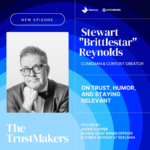By Mattia Fosci, CEO of Anonymised
If you’ve worked in digital marketing for longer than five minutes, you’ll know that last-touch attribution (LTA) has become the default method for campaign measurement. There’s a reason for that. It’s simple, it’s quick, and it tells a story that marketers can easily understand: someone saw an ad, then converted – job done.
But that story is a dangerous fiction.
LTA gives 100% of the credit for a conversion to the last touch point before the user made a purchase or completed a desired action (the touchpoint usually being an impression or an ad click). It does not matter what other ads were seen before that one, how the customer moved through the funnel, or which channels were most effective at influencing their journey. If your impression or click wasn’t last, it didn’t count.
This might sound like an innocent simplification. After all, digital advertising is complex, and some kind of attribution is better than none. But here’s the problem: this model distorts incentives, corrupts measurement, and creates a perverse game where the winner isn’t the advertiser or the publisher—it’s the party best positioned to intercept the user right before the finish line.
Cookie Bombing and the Race to the Bottom
Once you accept LTA as your measurement model, you immediately create a high-stakes competition: everyone wants to be the last to touch the user before they convert. This is where cookie bombing comes in. It’s the practice of dropping third-party cookies – or equivalent user identifiers – into as many bid requests as possible. The idea is to create a statistical link between your impression and the eventual conversion, regardless of whether your ad had any real influence.
The outcome? Entire ad budgets skewed towards those who are best at dropping IDs, not those who are best at driving impact. Media plans become a race to plant a flag on the user seconds before they convert, with little regard for the actual value each touchpoint delivers.
This might make for nice-looking reports, but it’s a shallow and deceptive form of measurement. It rewards tactics, not strategy. Hacking, not influence.
The Allure and the Trap
It’s not hard to see why last-touch attribution became dominant. It’s easy. It’s quick. It gives definitive answers. Marketers can go to their CFO and say, “This channel drove X conversions.” That kind of clarity is seductive. But the disadvantages are profound.
Let’s name them:
- LTA ignores true contribution: Channels that nurtured the customer, generated awareness, or drove engagement don’t get credit unless they were last. That’s not measurement, that’s misattribution.
- LTA inflates ROAS: If you’re claiming conversions that would have happened anyway, you’re overstating your impact and misallocating your budget.
- LTA optimises for ID-dropping, not impact: Budgets get shifted to channels that are best at deploying identifiers, rather than channels that actually influence behavior.
- LTA excludes ID-less impressions: Over 60% of impressions on the open web are ID-less. Under a last-touch model, they’re invisible. That’s a colossal blind spot.
- LTA skews the playing field: Channels like CTV or open web environments, where user identifiers are sparse and ephemeral, are disadvantaged, even if they play a critical role in influencing the customer. The credit goes to channels with large quantities of stable IDs and high frequency of usage because they have a greater chance of dropping an ad in front of a customer right before the conversion.
Last-Touch Attribution: A Trojan Horse for the Walled Gardens
Let’s focus on that last point. Last-touch attribution isn’t just flawed, it’s systematically biased in favour of the walled gardens. It’s a Trojan horse, smuggling in the dominance of the biggest platforms under the guise of “performance.”
Why?
- They have more IDs: Their sheer scale means they can tag more users and claim more conversions, even if the user was persuaded elsewhere.
- Their IDs are more stable: Unlike cookies or IP-based IDs, which degrade over time or get blocked, walled gardens have persistent identifiers tied to login data. That makes their match rates sky-high, meaning that they can link almost all conversions to an impressions.
- They are used daily: Users log into these platforms every day. That raises the probability that an ad impression from a walled garden will be the last one before a conversion, regardless of actual influence.
This means the platforms with the most data, the most IDs, and the highest daily usage get an outsized share of the credit. Not because they deserve it, but because the measurement framework hands it to them.
The Impact on the Open Web and CTV
Let’s be blunt: the open web loses under last-touch. So does CTV. These environments are rich, impactful, and often crucial to building awareness and intent. But they aren’t structured around user logins or persistent IDs. They don’t always get to be “last.”
And so, under last-touch, they get ignored.
Campaigns underperform not because the channels failed, but because the attribution model never gave them a chance. Impressions without IDs are excluded. Touchpoints that played a role in moving the customer forward are dismissed. Inventory that could drive real brand lift is sidelined in favour of whatever can plant an ID and “be last.”
Time to Move On
Everyone in the industry knows that last-touch attribution is flawed. The question isn’t whether we should move on, it’s why we haven’t yet. The answer is inertia, convenience, and entrenched interests.
But here’s what’s clear: if we care about accuracy, transparency and effectiveness, we must adopt a model that gives credit where credit is due. One that reflects the real contributions of each channel, including those without IDs. One that rebalances the playing field in favour of impact, not infrastructure.
Linear and positional attribution models paint a better picture than LTA, but the effectiveness of a campaign is only truly measured using cross-channel incrementality testing, brand lift studies or other comprehensive assessment. There’s a big opportunity for the industry to simplify, automate and reduce the cost of these methods so that businesses of all sizes can get a better picture of how their marketing investment is performing. Until then, let’s stop pretending that being “last” means being “best.”
About the Author
Mattia Fosci is CEO at Anonymised. For more information visit: anonymised.io











